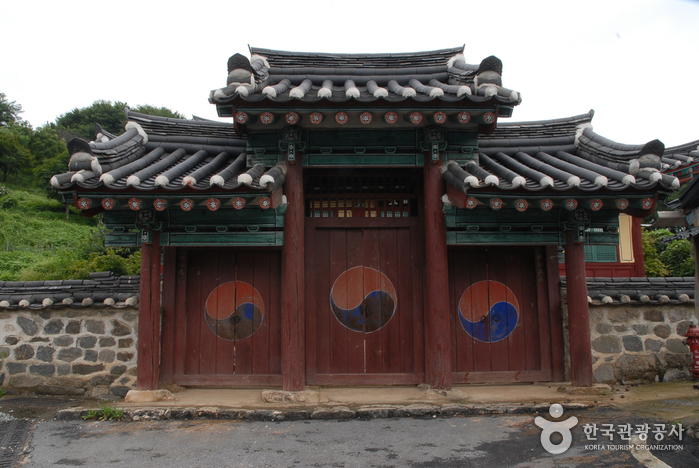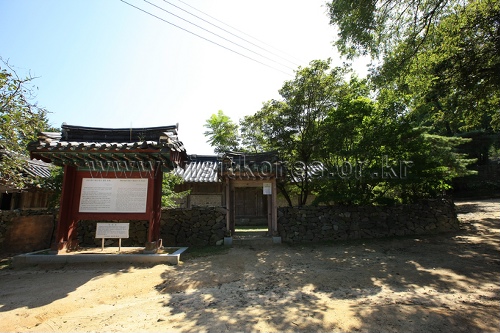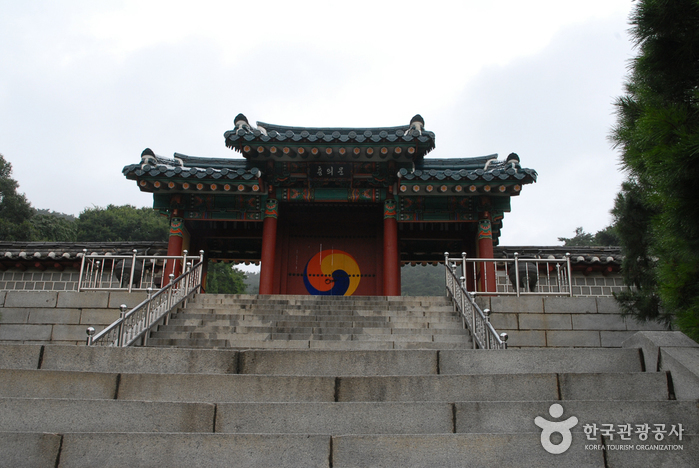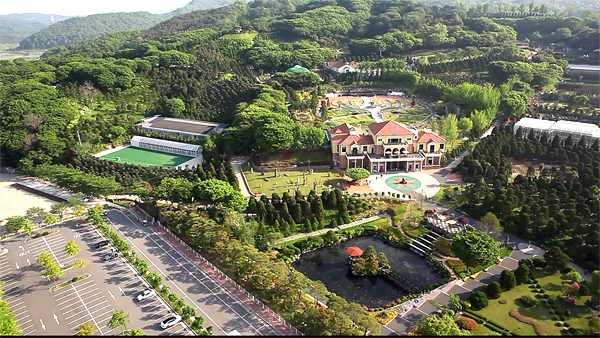Jeonuihyanggyo Confucian School (전의향교)
11.8Km 2025-05-20
5-18, Bukchon 1-gil, Sejong-si
+82-44-211-4022
Jeonuihyanggyo Confucian School is thought to have been built in 1413 during the 13th year of King Taejong’s reign. The school features a simple spatial arrangement with only Myeongnyundang and Daeseongjeon Study Halls, each with three gates in the front. Outside the western wall of Myeongnyundang Hall is Sujiksa Temple.
Several books - Jaeimnok, Seonan, several texts on rituals, and Eojeyuneum (1782-1783), which was published in 1782 (6th year of King Jeongjo’s reign) and 1783, have been found at Jeonui Hyanggyo.
Asan Maengssi Haengdan House - Maeng Sa-seong House (아산 맹씨행단(맹사성 고택)
12.0Km 2020-05-07
23-4, Haengdan-gil, Asan-si, Chungcheongnam-do
+82-41-536-8773
Maeng Sa-seong is a major figure in Cheonbaek-ri and was a prime minister during the early years of the Joseon dynasty. His house is the oldest private residence in Korea, and was originally General Choi Yeong’s home, before he turned it over to his grand son-in-law, Maeng Sa-seong. The simple residence houses two 600-year-old gingko trees in the yard. Therefore it has been named ‘Haengdan’, meaning that Confucius taught on top of the gingko tree symbolizing a place of learning. For that reason it is inferred that Maeng Sa-seong intentionally planted gingko trees in the yard and taught junior scholars. The two gingko trees provide a cool shade and give out five sacks of gingko nuts each year.
Hyeonchungsa Shrine (현충사)
12.4Km 2020-04-03
126, Hyeonchungsa-gil, Asan-si, Chungcheongnam-do
+82-41-539-4600
Hyeonchungsa Shrine, located in Asan-si, is the shrine of General Lee Sun-Shin (1545-1598). It was built in 1706, and named Hyeonchungsa Shrine the following year. In 1932 during the Japanese occupation, a treasure preservation committee was formed to protect the shrine. Afterward, the shrine was rebuilt by the government, its area greatly enlarged, and was further developed into a sacred place.
The shrine contains Sipkyeongdo, a pictorial biography of general Lee Sun-Shin’s portrait and his life story. Nanjung Diary, designated National Treasure No. 76, his Long Sword, Treasure No. 326, and other treasures are displayed within the shrine as well, together with the old house he lived in, the arrow shooting range, and Geobuksun (turtle ship). When you enter the of Hyeonchungsa Shrine, Chungmu gate, you will see another gate called Hongsal Gate. Go past Hongsal Gate and you can see Lee Sun-Shin’s portrait, which was made with Korean Cheonggiwa tiles and iron-reinforced concrete. Inside the Gotaek Building is the Chungmujeong House, where Lee Sun-Shin spent his life until he was a young man. The newly added pond, Yeonji Pond, in Hyeonchungsa Shrine is also worth exploring.
Uniqlo - Asan Punggi Branch [Tax Refund Shop] (유니클로 아산풍기)
12.9Km 2024-04-18
1692, Oncheon-daero, Asan-si, Chungcheongnam-do
-
Beartree Park (베어트리파크)
12.9Km 2025-05-20
217, Sinsong-ro, Sejong-si
+82-44-866-7766
Beartree Park is a beautiful natural space in Sejong founded by entrepreneur Lee Jae-yeon. The park first started out as a private garden cared for by Lee personally. The garden was turned into a park and opened to the public in 2009, boasting a beautiful collection of flora and fauna. Indoor and outdoor botanical gardens, junipers, wild flowers, irises, and bonsais are tended with the utmost of care. In addition to the magnificent gardens, visitors can also observe family of deer, bears, birds, and more.
Unjusanseong Fortress (운주산성)
13.0Km 2021-08-31
Migok-ri, Sejong-si
+82-44-300-3423
Unjusanseong Fortress, also known as Gosansanseong Fortress, is a cultural heritage of the Baekje dynasty. This is a mountain fortress built along the surrounding three mountain peaks in the westernmost and southernmost parts of Unjusan Mountain. The stone fortress wall, which borders three villages in Jeondong-myeon and two villages in Jeonui-myeon, is 3,210 meters long and two meters wide with a x_height that ranges from two to eight meters. The walls follow the natural geographical features of the mountain range, with the southern walls surrounding the mountain's peak.
Remnants of a village can still be observed within the fortress walls, such as the fortress gate and a ritual site. Pieces of earthenware from the Baekje period, porcelain from the Goryeo and Joseon periods, and broken tiles from the Baekje, Goryeo and Joseon periods have been discovered around the site as well.
E-Mart - Asan Branch [Tax Refund Shop] (이마트 아산)
13.1Km 2024-04-22
1678, Oncheon-daero, Asan-si, Chungcheongnam-do
-
Mokhwa Banjeom (Asan) [목화반점(아산)]
13.6Km 2024-02-21
7-3, Onju-gil 26beon-gil, Asan-si, Chungcheongnam-do
Mokhwa Banjeom is a Chinese restaurant in Asan enjoying a loyal following. Its expertise is evident in the popularity of customers’ favorites such as tangsuyuk (deep-fried pork with sweet and sour sauce), jjajangmyeon (black bean sauce noodles), and jjamppong (spicy seafood noodle soup). Many people visit this restaurant, so waiting is the norm. Mokhwa Banjeom’s signature dish is tangsuyuk (deep-fried pork with sweet and sour sauce), made with egg batter for a rich, crispy, yet fluffy texture.
Lotte Mart - Asan Terminal Branch [Tax Refund Shop] (롯데마트 아산터미널점)
13.6Km 2024-04-16
225, Beonyeong-ro, Asan-si, Chungcheongnam-do
-
Olive Young - Asan Terminal Branch [Tax Refund Shop] (올리브영 아산터미널)
13.7Km 2024-04-18
216, Beonyeong-ro, Asan-si, Chungcheongnam-do
-



![Uniqlo - Asan Punggi Branch [Tax Refund Shop] (유니클로 아산풍기)](http://tong.visitkorea.or.kr/cms/resource/08/2883308_image2_1.jpg)


![E-Mart - Asan Branch [Tax Refund Shop] (이마트 아산)](http://tong.visitkorea.or.kr/cms/resource/05/2883305_image2_1.jpg)
![Mokhwa Banjeom (Asan) [목화반점(아산)]](http://tong.visitkorea.or.kr/cms/resource/99/3050399_image2_1.jpg)
![Olive Young - Asan Terminal Branch [Tax Refund Shop] (올리브영 아산터미널)](http://tong.visitkorea.or.kr/cms/resource/94/2883294_image2_1.jpg)
 English
English
 한국어
한국어 日本語
日本語 中文(简体)
中文(简体) Deutsch
Deutsch Français
Français Español
Español Русский
Русский